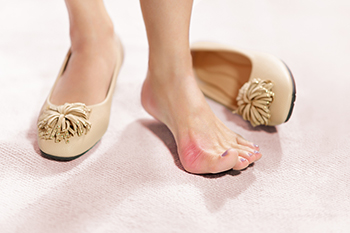Reasons a Bunion Can Develop
Tuesday, 30 August 2022 00:00
A bump on the side of the big toe may be classified as a bunion. It can be large or small depending on how fast it develops. It may be uncomfortable and can happen as a result of wearing shoes that do not have adequate room for the toes to move around in. Some patients have pain in the bottom of their big toe that may gradually develop into the rest of the foot. In severe cases, the bunion may cause the other toes to shift and can result in overlapping. Many patients choose to have an X-ray taken and this can be beneficial in determining the extent of the deformity, in addition to observing if there is wear and tear on the joint. This condition may be the result of an abnormal foot structure and may happen to people who have flat feet. Additional reasons why people may develop a bunion can be from having endured a foot injury or possibly from collagen deficiency diseases. If you have a bunion, please confer with a podiatrist who can recommend what type of treatment is correct for you, and how to find permanent relief.
If you are suffering from bunions, contact one of our podiatrists of Family Foot Care. Our doctors can provide the care you need to keep you pain-free and on your feet.
What Is a Bunion?
A bunion is formed of swollen tissue or an enlargement of boney growth, usually located at the base joint of the toe that connects to the foot. The swelling occurs due to the bones in the big toe shifting inward, which impacts the other toes of the foot. This causes the area around the base of the big toe to become inflamed and painful.
Why Do Bunions Form?
Genetics – Susceptibility to bunions are often hereditary
Stress on the feet – Poorly fitted and uncomfortable footwear that places stress on feet, such as heels, can worsen existing bunions
How Are Bunions Diagnosed?
Doctors often perform two tests – blood tests and x-rays – when trying to diagnose bunions, especially in the early stages of development. Blood tests help determine if the foot pain is being caused by something else, such as arthritis, while x-rays provide a clear picture of your bone structure to your doctor.
How Are Bunions Treated?
- Refrain from wearing heels or similar shoes that cause discomfort
- Select wider shoes that can provide more comfort and reduce pain
- Anti-inflammatory and pain management drugs
- Orthotics or foot inserts
- Surgery
If you have any questions, please feel free to contact our offices located in Valatie and Albany, NY . We offer the newest diagnostic and treatment technologies for all your foot care needs.



